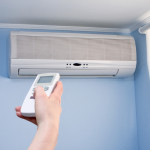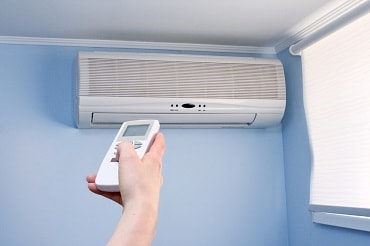 When choosing an air conditioner for our apartment, we, as a rule, look at such indicators as energy consumption, as well as minimum capabilities. Other functions of the air conditioner, for example, ventilation, the ability to dry the air, ionization and disinfection do not become so noticeable. Although manufacturers are ready to work on their air conditioners, make them according to the latest technologies, add new functions and modes to the air conditioner to make our stay at home as comfortable as possible.
When choosing an air conditioner for our apartment, we, as a rule, look at such indicators as energy consumption, as well as minimum capabilities. Other functions of the air conditioner, for example, ventilation, the ability to dry the air, ionization and disinfection do not become so noticeable. Although manufacturers are ready to work on their air conditioners, make them according to the latest technologies, add new functions and modes to the air conditioner to make our stay at home as comfortable as possible.
Let's get acquainted with the main modes of operation of various air conditioners and their capabilities provided to customers.
Heating and cooling
Any air conditioner is designed, first of all, to operate in the Cool mode. Cooling is through the use of physical processes. In this case, the refrigerant changes its state from liquid to gaseous, taking heat from the external environment. This is where the cooling of the air that enters the room occurs (the effect of drainage is created, since water is removed from the air stream). To calculate the capacity of the air conditioner, which will serve for cooling, the following calculations are required: 1 kilowatt falls on an area of 8 to 10 square meters for the air conditioner to work correctly.
Heating mode is activated by pressing the button with the “Heat” icon. "Heat" is the supply of warm air at a sufficient temperature for heating.
The “Heat” mode is ideal for heating, as it emits 3 to 4 times more heat in comparison with the electricity spent on it. It is good for use in spring and autumn, the modes are just suitable for heating a room.

But in winter, at negative temperatures, freon and compressor oil are able to change their characteristics. The air conditioner may fail in a short time due to its malfunction. In such a situation, it is necessary to use a specially designed kit that is ready to work at temperatures up to minus thirty degrees. But then you will get not only a heater, but also your money costs for electricity will noticeably increase, since its device will need much more.
There are air conditioners that are equipped with a heating tenon. Their disadvantage also lies in the high consumption of electricity, which leads to a more serious waste of money (unlike other types of heaters).
See also:
- 5 best Toshiba air conditioners 2025 of the year
- 5 best Panasonic air conditioners 2025 of the year
- 5 best LG air conditioners 2025 of the year
- 5 best Daikin air conditioners 2025 of the year
- 6 best Mitsubishi Electric air conditioners 2025 of the year
Ventilation (fan)
This mode of the device includes only a fan located inside, it captures air from the external environment, but it does not lend itself to heating or cooling. The use of such a function is excellent when the building is heated by a central heating system.
It is possible not to turn on the air intake from the street, then the air conditioner skillfully mixes different layers of air, which have different degrees of heating (warm air at the top, it is colder at the floor).
More modern models in the technical plan have the ability to adjust the fan speed, due to which a different ventilation capacity is created.
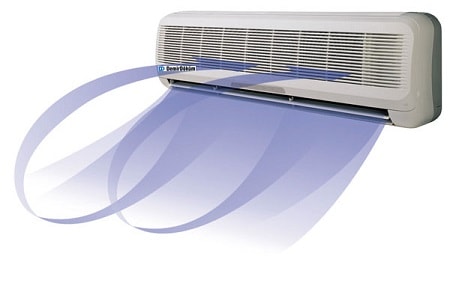
Dry mode (dry)
It is designed for rooms with very high humidity, in this mode, moisture remains on a cold surface (condensation occurs). The air is also dehumidified during simple cooling, but this is not so noticeable.
In addition, when operating in the "dry" mode, the temperature remains practically the same, the compressor starts its work when there is a change in which there is a deviation from the normal temperature by at least one degree more or 0.5 degree less. Draining takes place for ten minutes, then five and a half minutes - a pause, and then 2 minutes of ventilation. Then the mode is repeated over and over again.
![]() See also - How to turn on the heating mode on the air conditioner
See also - How to turn on the heating mode on the air conditioner
The choice of automatic modes (auto)
This function allows the air conditioner to make a choice on its own, choosing rational operating modes for you. The device automatically chooses which mode will achieve the user's requirements in the best quality (ventilation has several cycles, which are combined, heating and cooling, if necessary, replace each other). Work in auto mode occurs in various ways, if necessary, the system itself includes the dehumidification of the air flow to obtain the desired temperature.
Enabling Comfort Sleep (Quiet, Sleep)
Work in this mode is based on reducing the number of rotations of the fan from the outside to the minimum mark, with the help of which the air conditioner works silently without disturbing sleep. In addition, the device carefully monitors the temperature and slowly increases or decreases the degrees, if necessary (when there are deviations from the norms).
"Comfortable sleep" significantly reduces the cost of electricity: work stops immediately after the set time has elapsed.
Timer. Using the timer, it is possible to set the temperature before your arrival, as well as shut down the air conditioner after the required amount of time (set by the remote control).
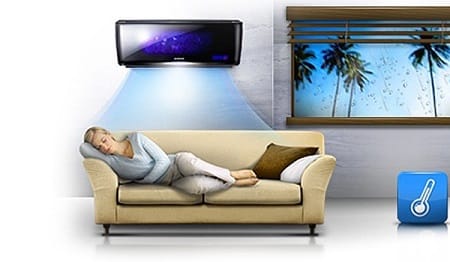
Defrosting a heat exchanger
With the help of the system electronics, when the unit is turned on, the temperature of the refrigerant contained in the outdoor unit is measured. When the heating mode is turned on, the refrigerant collects the cold obtained from the air masses of the external environment, this leads it to defrosting.
This feature is useful when operating systems in low temperatures.
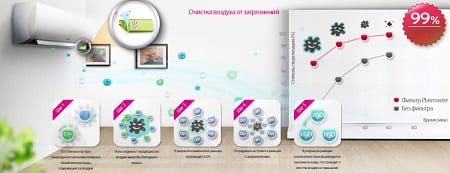
Air filtration and purification
Today air conditioners have multi-stage filters that can exclude large amounts of dust and dangerous microorganisms from entering the air. Filters are cleaned in 3 stages. In the first degree, the air stream is coarsely cleaned with a fine metal grate, in the second, microbes and pollen of plants are removed using an electrostatic filter, and in the third, elements of tobacco smoke and other unpleasant odors are removed. These are very important cleaning steps that remove visible and invisible microorganisms and odors that are harmful to health.
See also:


